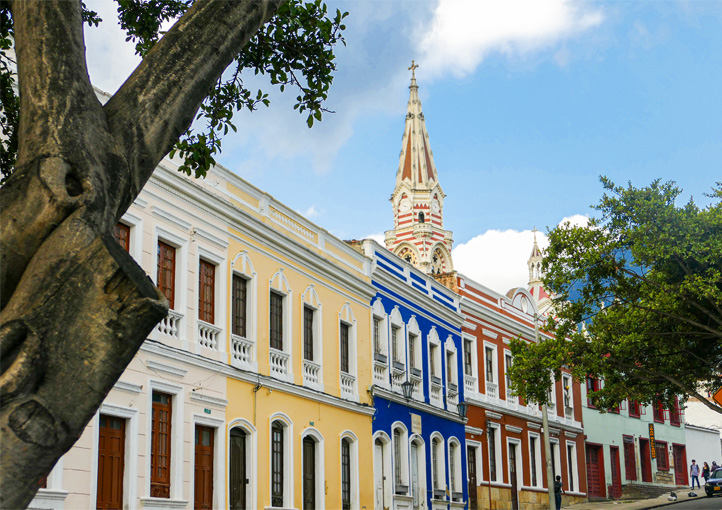Updated on 04/30/2024
Dear reader,
I would also like to recommend our Colombia travel guide, which provides a perfect overview of the tourist attractions in Colombia. Enjoy reading it!
Content
Toggle La Candelaria or the Historic Center of Bogota, Colombia
La Candelaria or the Historic Center of Bogota, Colombia
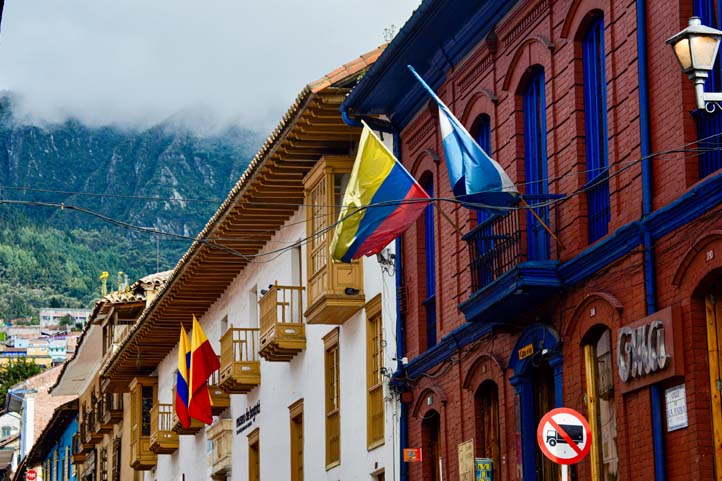
La Candelaria, the historic heart of Bogota, Colombia, is not only a testament to the city’s rich history but also a mirror reflecting its social and urban evolution.
The Foundation and Growth of La Candelaria
- Historic Significance: Established in 1538, La Candelaria is characterized by its colonial architecture, cobblestone streets, and historic churches.
- Cultural Hub: Originally, it was the center of wealth and power, with grand villas and estates indicative of the upper-class lifestyle.
The 1948 Catalyst: Jorge Eliécer Gaitán’s Assassination
- Event: Gaitán, a popular leader, was assassinated on April 9, 1948.
- Aftermath: His death led to the Bogotazo riots and ignited “La Violencia,” a brutal civil war lasting until 1958.
- Impact: The riots caused extensive damage to the city, including the destruction of the tram infrastructure, a vital transportation mode at the time.
Post-War Urban Shifts
- Demographic Change: The wealthy residents moved north, leaving La Candelaria to face decay and urban challenges.
- Security Concerns: For decades, the area struggled with safety issues, diminishing its prestige.
Revival and Transformation (2009-2020)
- Tourism Influence: Starting around 2009, increased international tourism began to revitalize the area.
- Urban Renewal: Investments in infrastructure and restoration projects were initiated to preserve historic buildings and public spaces.
- Cultural Renaissance: The area has seen a resurgence of cultural activities, museums, art galleries, and universities, attracting both tourists and locals.
Contemporary Challenges and Urban Dynamics
- Preservation vs. Modernization: The integration of modern structures with the colonial architecture remains a challenge.
- Legislative Hurdles: Efforts to protect La Candelaria’s historical integrity are often hampered by bureaucratic red tape and corruption.
- Population Density: As of 2020, Bogota’s population is over 7 million, with La Candelaria remaining a densely populated area, reflecting a mix of residential, commercial, and cultural spaces.
La Candelaria Today
- Political Significance: It houses important governmental buildings, including the seat of the president and the parliament.
- Cultural Identity: La Candelaria has become a symbol of Bogota’s historical and cultural identity, attracting a mix of academia, artistry, and tourism.
- Future Potential: There is ongoing potential for La Candelaria to become one of the most significant historical urban centers in Latin America, provided that balance between preservation and modern development is maintained.
La Candelaria’s journey from a colonial stronghold to a modern urban center reflects Bogota’s broader history, showcasing the city’s ability to evolve while preserving its rich cultural heritage.
Bolivar Square: A Cultural and Historical Epicenter in Bogota
Overview and Location
- Size and Capacity: Spanning approximately 14,000 square meters (150,000 square feet), Bolivar Square can accommodate over 55,000 people.
- Geographic Position: Located at the junction of Carrera 7a & 8a, Calle 10a & 11a, it is a central point in Bogota.
Architectural and Historical Significance
- Surrounding Landmarks: The square is flanked by significant buildings including the Palace of Justice, the Catedral Basilica Metropolitana, the Capitol, and the Congress building.
- Colonial Legacy: These structures are pivotal in understanding Colombia’s colonial and political history.
Contemporary Role and Activities
- Versatile Public Space: Bolivar Square serves various purposes – from a tourist attraction and a local meetup spot to a venue for concerts and events.
- Pedestrian Zone: The square also marks the beginning of the pedestrian zone of Carrera 7, adding to its accessibility and popularity.
Cultural Practices and Cautions
- Photography and Pigeon Feeding: The square is popular for photography enthusiasts and feeding pigeons, despite the associated health risks with bird feeding.
- Health Considerations: In many cities worldwide, pigeon feeding is discouraged or prohibited due to health risks and efforts to control pigeon populations.
Bolivar Square remains a vital part of Bogota’s cultural and historical landscape, reflecting the city’s rich heritage while serving as a dynamic hub for public life.
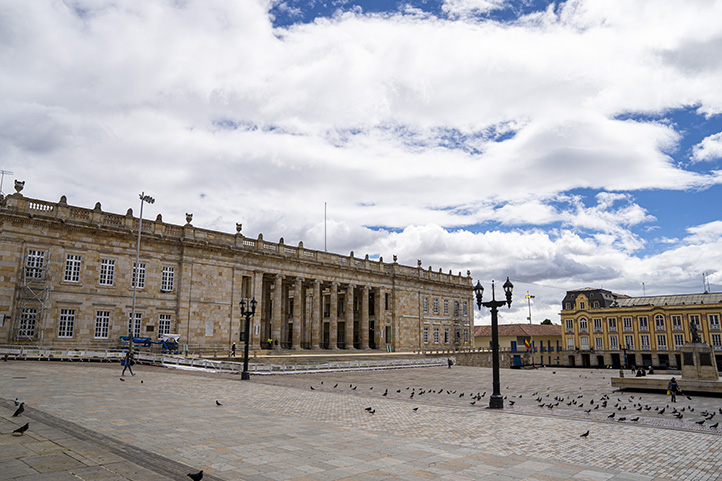
Botero Museum
Introduction
Located in the heart of Bogota’s old town, the Botero Museum stands as one of Colombia’s most significant cultural landmarks.
Location
- Address: Calle 11 # 4-41, nestled in the historic center of Bogota, making it easily accessible for visitors.
Fernando Botero and His Legacy
- Fernando Botero Angulo: Born in 1932, Botero is one of Colombia’s most renowned artists, celebrated for his unique style and contributions to the art world.
- Significant Donation: In 2000, Botero donated 208 artworks valued at over $200 million, including 123 of his own creations.
The Collection
- Diverse Artworks: Contrary to common misconceptions, the museum’s collection goes beyond Botero’s famous depictions of “chubby figures.”
- International Masters: The museum also houses 85 works from global artists and grandmasters such as Alberto Giacometti, Camille Pissarro, Edgar Degas, Eugène Louis Boudin, Francis Bacon, Gustave Caillebotte, Henry Spencer Moore, Joan Miró, Joseph Fernand Henri Léger, Oscar-Claude Monet, Pablo Picasso, Pierre-Auguste Renoir, and Salvador Domingo Felipe Jacinto Dalí.
Visitor Experience
- Free Admission: The museum offers free entry, making it accessible to a wide audience.
- Unrestricted Viewing: Visitors can view the artworks without any significant restrictions, a rare opportunity in the world of prestigious art collections.
- Recommendation for All: The museum is highly recommended even for those who might not be well-versed in art, offering an enriching experience for all visitors.
The Botero Museum is not just a showcase of Fernando Botero’s works but a celebration of artistic diversity, making it a must-visit destination for anyone exploring the cultural landscape of Bogota.
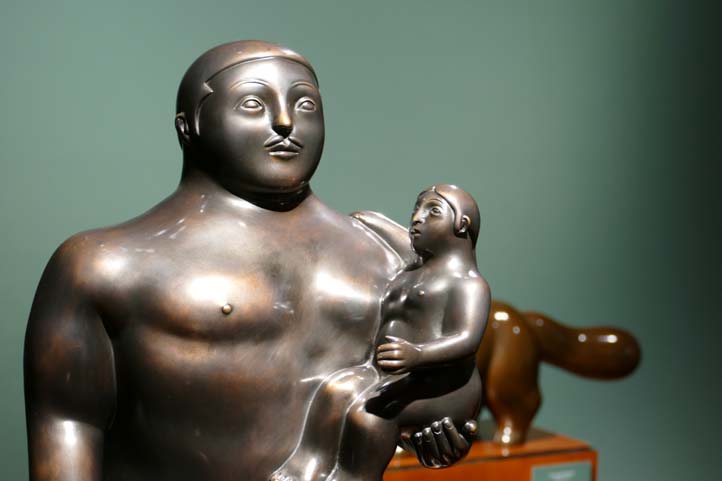
La Puerta Falsa Restaurant: A Culinary Institution in Bogota
Introduction
La Puerta Falsa, which intriguingly translates to ‘the wrong door’, holds the distinction of being the oldest restaurant in Colombia.
Location and History
- Address: Calle 11 # 6-50, situated in a historical area of Bogota.
- Historical Significance: The building dates back to around 1600, and the restaurant has been serving customers for over two centuries.
The Restaurant’s Ambiance
- Deceptive Size: From the outside, La Puerta Falsa appears modest, but the interior reveals a more spacious dining area.
- Authentic Atmosphere: The restaurant maintains a traditional Colombian ambiance, reflecting its rich history and cultural heritage.
Culinary Offerings
La Puerta Falsa is renowned for its authentic Colombian cuisine, featuring classic dishes that are integral to the country’s culinary landscape. Here are some notable dishes:
- Ajiaco: A traditional Colombian soup made with chicken, potatoes, and the herb guasca, typically served with corn, avocado, and capers.
- Tamal: A staple in Colombian cuisine, tamales are corn dough filled with a mixture of meats, vegetables, and spices, wrapped in banana leaves and steamed.
- Chocolate con Queso: A unique combination where hot chocolate is served with a slice of cheese, a quintessentially Colombian comfort food.
- Tamal Santafereño: A regional variation of the traditional tamal, specific to the Santa Fe region, know
Casa Nariño: The Presidential Palace of Colombia
Overview
Casa Nariño, located at Carrera 8 # 7-26, serves as the official residence and working office of the President of Colombia. This iconic palace, completed in 1908, is a key symbol of the nation’s political history and architecture.
Architectural and Historical Significance
- Completion Year: The palace was completed in 1908, showcasing early 20th-century architectural styles.
- Garden and Observatory: Casa Nariño’s garden houses an old observatory, adding to its historical and scientific interest.
Visiting Casa Nariño
- Online Registration: Visitors must register online to tour Casa Nariño, providing information for a security check.
- Tour Languages: Tours are available in both Spanish and English, although the availability of an English-speaking guide is not guaranteed.
- Confirmation and Cancellations: Participants receive tour confirmations via email, but tours may be subject to last-minute cancellations or changes.
The Tour Experience
- Visual Feast: The palace itself is a marvel, with its stunning architecture and opulent decor.
- Art and Furnishings: Inside, visitors can admire an array of artworks and furnishings, each with its own story and historical significance.
- Recommendation: The tour of Casa Nariño comes highly recommended for its educational and visual experience, offering a unique glimpse into Colombia’s presidential history and culture.
A visit to Casa Nariño is not just a tour of a building but an exploration of Colombian heritage, combining political history, art, and architecture, making it a must-see destination in Bogota.
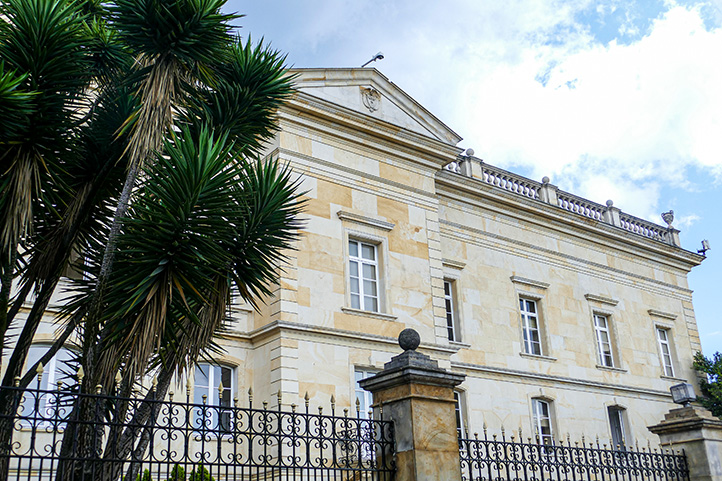
Colón Theater: A Cultural Landmark in Bogota
Introduction
Teatro de Cristóbal Colón, commonly known as the Colón Theater, is recognized as one of the seven wonders of Colombia. Located in the heart of Bogota’s old town, near Plaza Bolivar, it stands as a testament to Colombia’s rich cultural heritage.
Location and Architectural Details
- Address: Calle 10 # 5-32, situated in a historically significant area of Bogota.
- Architectural Style: The theater, whose cornerstone was laid in 1885, is designed in a neoclassical style, reflecting the architectural trends of the era.
Capacity and Performances
- Seating Capacity: The theater can accommodate up to 900 spectators, making it a significant venue for performances in the city.
- Regular Performances: It hosts a variety of shows and events, showcasing both local and international talent.
Tours and Accessibility
- Theater Tours: Visitors can explore the theater through guided tours, offering insights into its architecture, history, and operational aspects.
- Language of Tours: Public tours are primarily offered in Spanish, catering to the local audience.
Significance and Recommendation
- Cultural Importance: Beyond its architectural beauty, the theater is renowned for its intriguing history and role in the Colombian arts scene.
- Visitor Experience: A visit to the Colón Theater is highly recommended, not only for its aesthetic appeal but also for the cultural and historical insights it offers.
The Colón Theater is more than just a performance venue; it’s a cornerstone of Bogota’s cultural identity, making it a must-visit destination for anyone interested in the arts and history of Colombia.
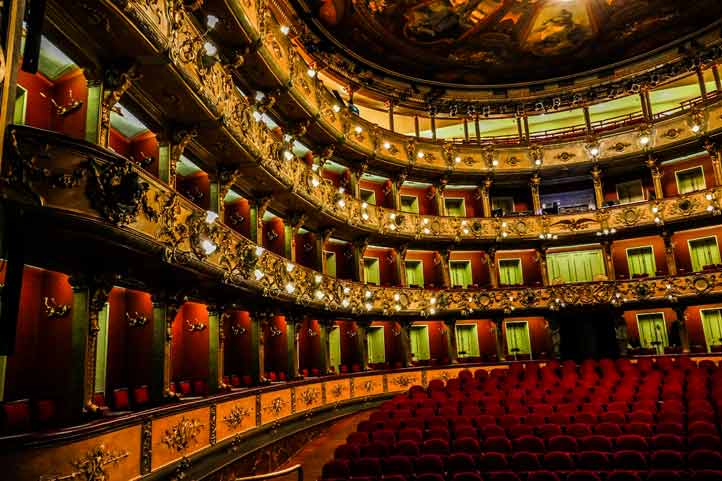
Chorro de Quevedo: The Historical Birthplace of Bogota
Overview
Chorro de Quevedo, often referred to as “Chorro” by locals, holds a special place in Bogota’s history as the city’s birthplace.
Location and Historical Significance
- Address: Calle 12b # 2-98, located in a historically rich area of Bogota.
- San Miguel Church: The small church on the outskirts, a replica, is considered Bogota’s first church, marking the historical significance of the location.
Contemporary Use of the Square
- Public Space: Today, the square is a vibrant public space where various art performances are showcased.
- Cultural Significance: The square is known for the sale of Chicha, a traditional fermented corn drink, reflecting the area’s deep-rooted cultural heritage.
Social Dynamics
- Recreational Activities: In the absence of police presence, the square sometimes becomes a spot for marijuana smoking and alcohol consumption.
- Legal Stance: It’s important to note that public consumption of alcohol and drugs is generally prohibited in Colombia.
Cultural and Social Importance
Chorro de Quevedo is not just a historical landmark but also a lively cultural hub, reflecting both the traditional and contemporary facets of Bogota’s social life. While it offers a glimpse into the city’s origins, the square is also a testament to the dynamic and evolving urban culture of Bogota.
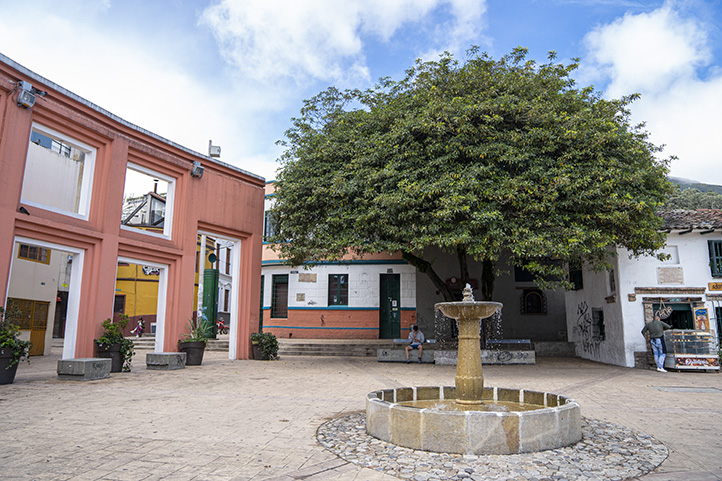
Rooftop Coffee at the University of Externado: A Hidden Gem in Bogota
Overview
The rooftop coffee spot at the University of Externado, located at Calle 12 # 1-17, is a lesser-known treasure in Bogota, offering a unique perspective of the city.
University of Externado
- Prestigious Institution: Externado University is a private university, renowned as one of Colombia’s top educational institutions.
- Architectural Landmark: Its striking and tall buildings are a notable feature of Bogota’s cityscape.
The Rooftop Coffee Experience
- Exclusive View: Situated on the roof of one of the university’s buildings, the coffee spot offers a magnificent view of Bogota’s old town.
- Unique Discovery: This location is a hidden gem, often overlooked in mainstream travel guides, and was discovered while seeking a vantage point for drone photography.
Access and Security
- Entry Protocol: Visitors should be aware that upon entering the building, they are likely to be stopped and questioned by a security guard as part of the university’s safety measures.
Recommendation
For those looking for a unique and serene place to enjoy a coffee with a view, the rooftop coffee at the University of Externado offers an unparalleled experience. It’s a perfect spot for both locals and tourists who wish to enjoy a quiet moment away from the hustle and bustle of the city, all while taking in the stunning vistas of Bogota’s historic areas.
Palace of Justice: A Symbol of Colombian History and Conflict
Location and Significance
- Address: Calle 12 # 7-65, prominently located on Plaza Bolivar in Bogota.
- Architectural and Historical Importance: The Palace of Justice is not only one of Colombia’s most iconic buildings but also a significant site in the nation’s history.
Historical Events of 1985
- Guerrilla Occupation: In 1985, the Palace of Justice was notoriously occupied by the M-19 guerrilla group, marking a dark chapter in Colombian history.
- Military Response: The Colombian military’s intervention involved tanks and heavily armed soldiers, leading to a dramatic and violent confrontation.
International Recognition
- Depiction in Media: The events at the Palace of Justice gained international attention, particularly through their portrayal in the popular Netflix series “Narcos.”
- Iconic Imagery: The images of the military storming the building have become emblematic, circulating globally and contributing to the building’s fame.
Contemporary Status
Today, the Palace of Justice stands as a somber reminder of Colombia’s turbulent past, particularly the intense political and social conflicts of the late 20th century. Its presence on Plaza Bolivar not only underscores its architectural prominence but also its enduring significance in Colombian history and culture. The site remains a point of interest for both locals and visitors, offering a stark insight into a pivotal moment in Colombia’s journey towards peace and stability.
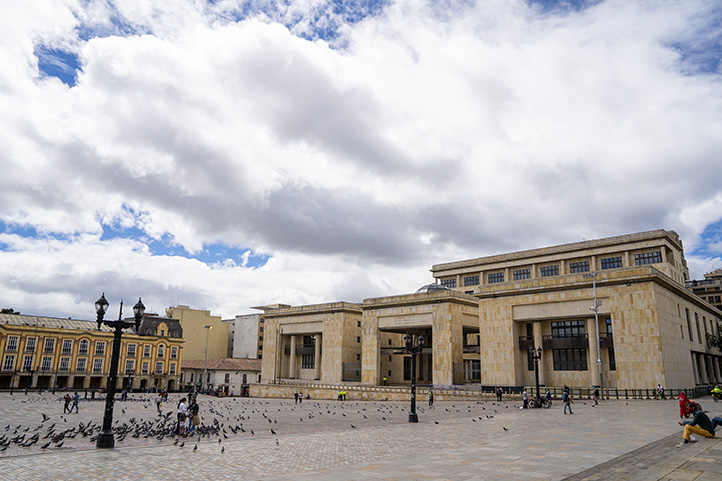
Military Museum: A Fascinating Glimpse into Colombia’s Military History
Location and Architectural Appeal
- Address: Calle 10 # 4-92, situated in a historically significant area of Bogota.
- Architectural Beauty: The building housing the military museum is notable for its striking design, adding to the allure of the museum experience.
Museum Features
- Exterior Displays: Even before entering, visitors can glimpse military vehicles and cannons in the courtyard, visible from the street.
- Rich Military History: Inside, the museum showcases an extensive collection of military artifacts, offering insights into Colombia’s military past.
Personal Recommendation
- Insider’s Perspective: As a former infantry officer, the museum holds a special significance and offers an engaging experience for those interested in military history and affairs.
- Visitor Experience: The museum is highly recommended for its comprehensive displays and the unique perspective it provides on Colombian military history.
The Military Museum in Bogota is more than just a collection of artifacts; it’s a journey through the nation’s armed forces’ history, providing visitors with an in-depth look at the military’s role in shaping Colombia. It’s an ideal destination for history buffs, military enthusiasts, and anyone interested in understanding a crucial aspect of Colombia’s national identity.
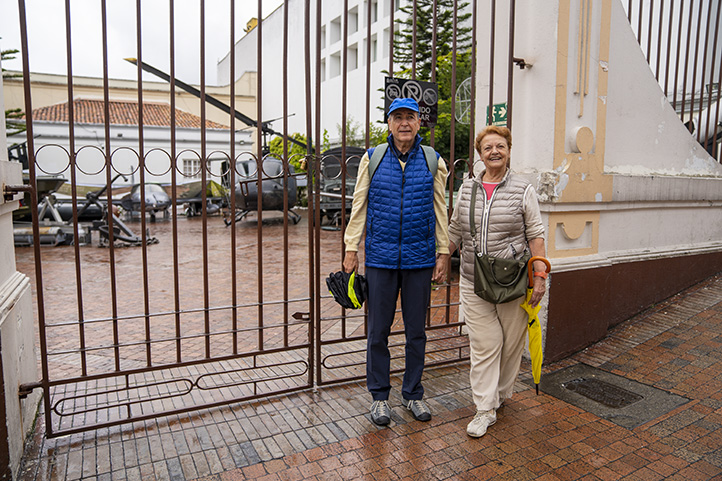
Luis Ángel Arango Library: A Cultural Beacon in Bogota’s Old Town
Location and Architectural Significance
- Address: Calle 24 # 16-5, prominently situated within the historic center of Bogota.
- Architectural Marvel: The library is not only a significant educational resource but also an architectural gem, blending seamlessly with the old town’s historical charm.
Access and Security
- Entry Protocol: Access to the library is free, but visitors must pass through a metal detector, ensuring safety and security within the premises.
Historical Background and Collection
- Establishment: The Luis Ángel Arango Library was founded in 1958, marking an important addition to Bogota’s cultural landscape.
- Extensive Collection: Today, the library boasts a collection of over 1 million books, making it one of the largest and most comprehensive libraries in Colombia.
Facilities and Cultural Offerings
- Multipurpose Spaces: The library houses various event rooms, offering a venue for diverse cultural and educational activities.
- Sound Recordings and Concert Hall: It also features facilities for sound recordings and a concert hall, enhancing its role as a cultural hub.
Cultural Importance
The Luis Ángel Arango Library stands as a testament to Colombia’s commitment to education and culture. Its vast collection of books and multipurpose facilities make it a vital resource for students, researchers, and the general public. As a prominent feature in the old town, the library not only serves as a center for learning but also as a symbol of the city’s architectural and cultural heritage, making it a must-visit destination for anyone exploring Bogota’s rich cultural scene.
Catedral Primada de Colombia: A Historic Landmark in Bogota
Location and Prominence
- Address: Carrera 7 # 10-40, prominently situated on Bolivar Square in Bogota.
- Visual Landmark: The Cathedral of the Immaculate Conception is an unmissable feature on the square, commanding attention with its grandeur.
Historical Background
- Construction History: The current structure dates back to 1823, built after three previous iterations of the building.
- Architectural Evolution: The cathedral’s history reflects the architectural and cultural development of Bogota over centuries.
Architectural and Cultural Significance
- Exterior Vantage Point: The forecourt of the cathedral provides a perfect spot for photography enthusiasts, offering stunning views of Bolivar Square.
- Social Hub: The steps leading to the square are a popular gathering place, frequented by a diverse range of people, adding to the location’s vibrant atmosphere.
Visitor Experience
- Photography Opportunities: Visitors can capture the essence of Bogota’s historical center from the cathedral’s vantage points.
- Cultural Immersion: The cathedral offers a chance to immerse oneself in the religious and historical significance of the city.
The Catedral Primada de Colombia is not just a place of worship but a symbol of Bogota’s rich history and architectural heritage. Its prominent location on Bolivar Square makes it a focal point for tourists and locals alike, serving as a gateway to exploring the cultural heart of the city.
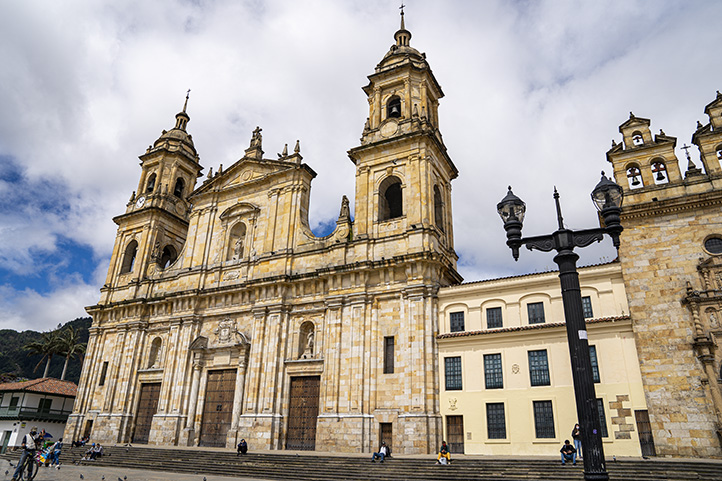
Iglesia de Nuestra Señora del Carmen: A Distinctive Architectural Marvel in Bogota
Location and Visual Appeal
- Address: Carrera 5 # 8-36, nestled within the vibrant streets of Bogota.
- Striking Design: The church is immediately recognizable for its unique white and red pattern, a visual standout among Bogota’s churches.
Historical and Architectural Significance
- Construction History: Completed in 1938, the church is relatively modern compared to many historical sites in Bogota.
- Interior Design: The church’s interior continues the striking color scheme, creating a visually stunning experience for visitors.
Visitor Experience
- Must-Visit Site: If you’re looking to explore a church in Bogota, Iglesia de Nuestra Señora del Carmen comes highly recommended for its unique architectural beauty.
- Photography Opportunity: The church’s distinctive design makes it a fantastic subject for photography, capturing a piece of Bogota’s diverse architectural landscape.
The Iglesia de Nuestra Señora del Carmen is more than just a place of worship; it’s an architectural icon in Bogota. Its unique design sets it apart, making it a captivating destination for both tourists and locals interested in the city’s cultural and architectural diversity.
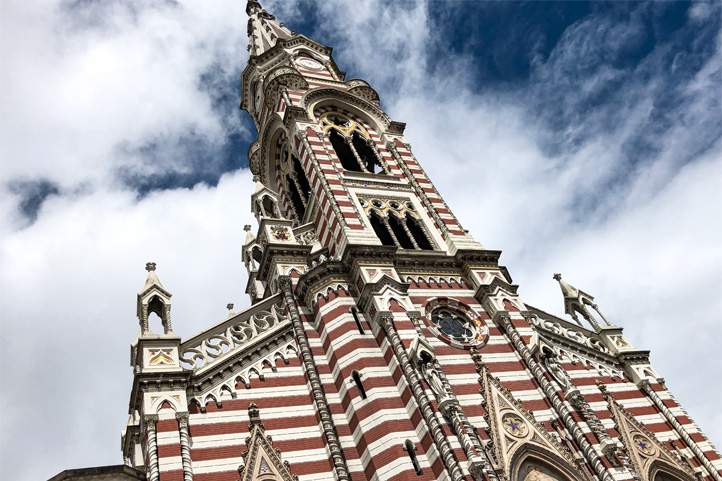
Carrera 7: The Vibrant Heartbeat of Bogota’s Street Life
Overview
Carrera 7, transformed into a pedestrian zone, stands as a lively and dynamic artery in the heart of Bogota, especially bustling on Sundays and public holidays.
The Chaotic Charm of Carrera 7
- Bustling Atmosphere: The street becomes a hub of activity, filled with a diverse mix of people and performances.
- Street Artists and Performers: Visitors can expect to see a wide array of street artists, ranging from robotic and predator-themed acts to dancing elderly men with unique mustaches.
A Melting Pot of Activities
- Diverse Crowds: The street is a convergence point for cyclists, pedestrians, artists, and vendors, each adding their unique flavor to the street’s ambiance.
- Variety of Experiences: The mix of performances, arts, and street vendors offers a rich tapestry of local culture and entertainment.
A Must-Visit for an Authentic Local Experience
- Cultural Immersion: Carrera 7 provides a quintessential Bogota experience, reflecting the city’s lively street culture.
- Recommendation: A stroll down Carrera 7 is highly recommended for those seeking to immerse themselves in the local way of life and enjoy an authentic slice of Bogota.
Carrera 7 epitomizes the vibrancy of Bogota’s street life, offering an unfiltered view of the city’s dynamic and diverse cultural landscape. It’s a place where the city’s pulse can truly be felt and experienced, making it a must-visit for anyone looking to connect with the essence of Bogota.
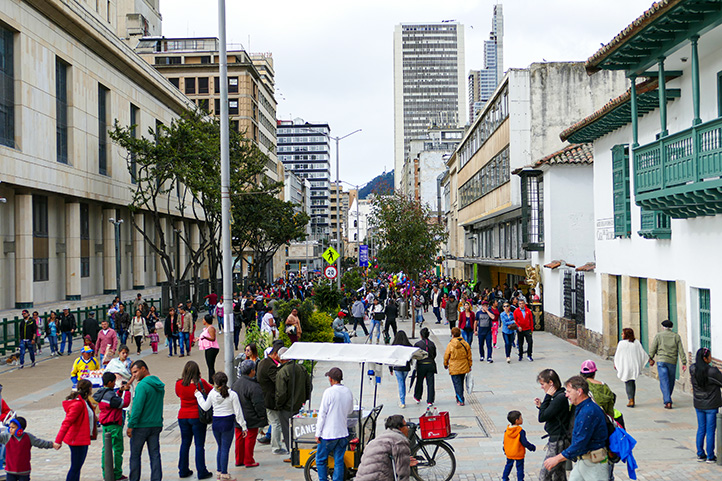
Quinta de Bolívar: A Glimpse into the Life of Simon Bolivar
Location and Proximity
- Address: Calle 21 # 4-30, conveniently located just a short walk from Bogota’s old town.
- Nearby Landmarks: The residence is situated en route to the local mountain Monserrate and adjacent to the Universidad de Los Andes, making it easily accessible for visitors.
Historical Significance
- Former Residence: Quinta de Bolívar served as the home of Simon Bolivar, the renowned general and liberator, a figure central to South American independence.
- 19th Century Insight: The house, now a museum, offers a window into the lifestyle and times of the 19th century, particularly focusing on the life of Simon Bolivar.
Museum Features
- Preserved Interiors: The interiors and furnishings have been preserved and restored, providing an authentic representation of Bolivar’s living environment.
- Cultural and Educational Experience: Visitors can explore various rooms and exhibits that shed light on Bolivar’s personal life, political endeavors, and his influence on South American history.
Visitor Experience
- Cultural Immersion: A visit to Quinta de Bolívar is not only educational but also a journey back in time, offering an immersive experience into a pivotal period in Colombian and South American history.
- Accessibility: Its location, just outside the old town and near other landmarks, makes it a convenient and enriching addition to any tour of Bogota.
Quinta de Bolívar stands as a testament to the legacy of Simon Bolivar and serves as a cultural treasure for those interested in understanding the historical roots and heritage of Colombia and South America.
La Concordia Market: A Fresh Perspective on Colombian Agriculture
Location and Recent Renovations
- Address: Calle 12c # 1-40, situated in an easily accessible area of Bogota.
- Modernized Facilities: Both the street leading to the market and the main building itself have undergone recent renovations, enhancing the overall visitor experience.
The Market Experience
- Agricultural Showcase: La Concordia Market is an excellent spot for those looking to explore Colombia’s diverse agricultural products. It offers a vivid display of the country’s rich agricultural heritage.
- Affordable Dining Options: The market is also a great destination for visitors seeking a budget-friendly yet delicious lunch, providing a taste of local flavors and cuisines.
Visitor Recommendations
- Insider Tip: Regular visits by locals, including myself, attest to the market’s appeal and authenticity. It’s a perfect place for both locals and tourists to experience the real Bogota.
- Cultural and Culinary Insight: For anyone interested in understanding Colombian agriculture and culinary practices, a visit to La Concordia Market is highly recommended.
La Concordia Market not only serves as a hub for fresh, local produce but also as a cultural meeting point, where visitors can immerse themselves in the daily life and gastronomic traditions of Bogota.
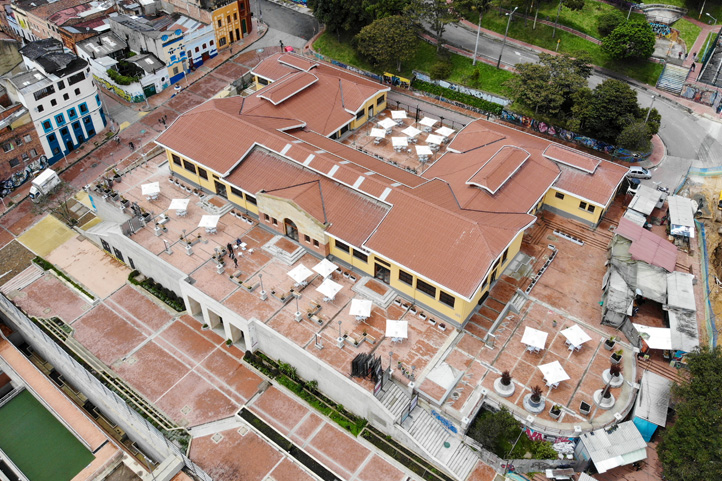
Colombia Travel Tips
- Colombia Travel Medical Advice & Vaccination Details
- 29 Travel Tips You Need To Know Before Coming To Colombia
- 99 Facts & Information About Colombia You Should Know
- Colombia Weather Guide for Travelers
More Destinations in Colombia
- 99 Must-See Destinations that Will Make You Fall in Love with Colombia
- Colombia’s Top 23 Largest and most Important Cities – Key Data and Insights
- 7 Wonders of Colombia Complete Guide
- Colombia’s Top 117 Museums: A Cultural Traveler’s Comprehensive Journey
- 21 Spectacular Churches in Colombia
- What Are The Best Luxury Destinations In Colombia?
- Sample Luxury Travel Itinerary in Colombia
- Instagram Colombia – The 17 Most Beautiful Places for Photos

